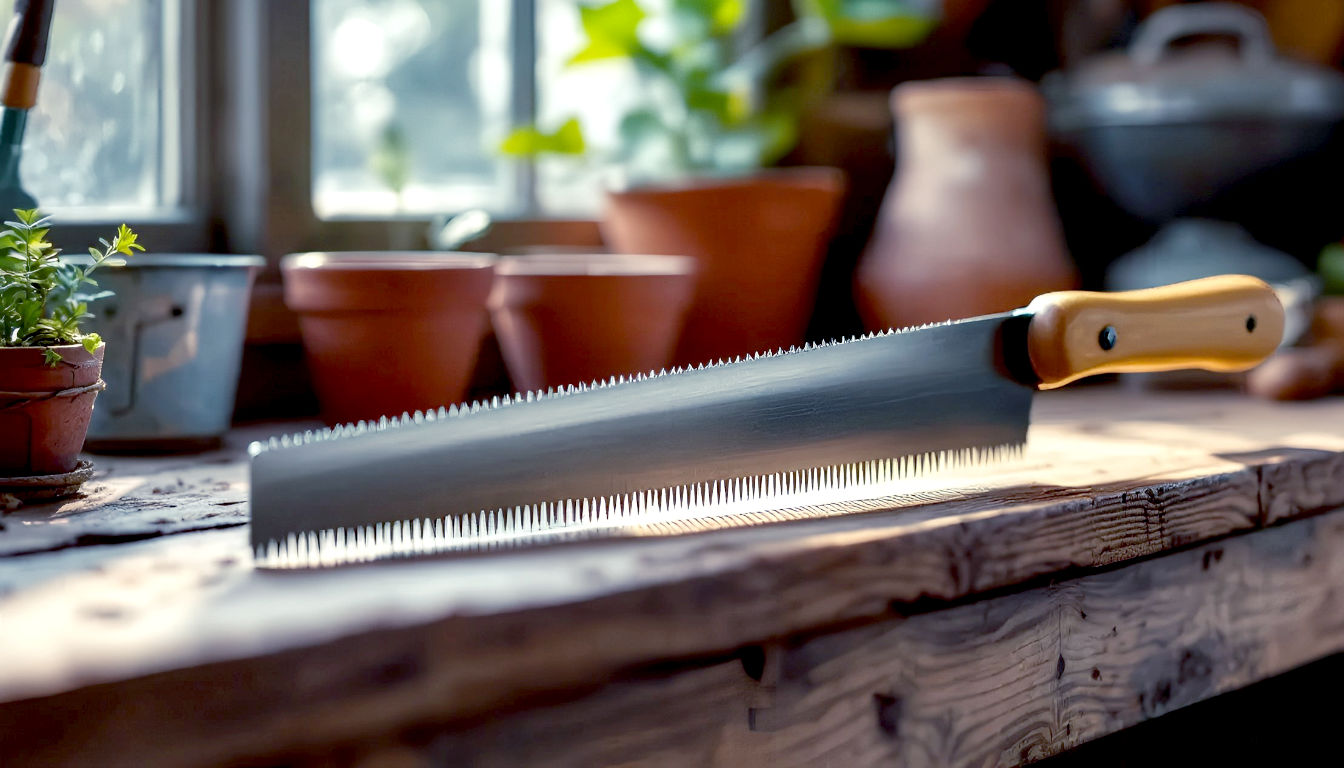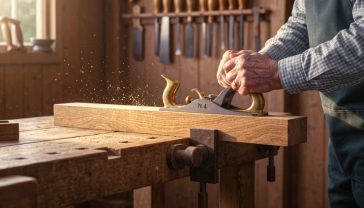The Japanese Handsaw Review: A British DIYer’s Guide to the Heatigo Small Wood Saw
Discover the secrets of Japanese saws with our definitive review of the Heatigo handsaw. We test its dual-blade on garden branches, flat-pack furniture, and more.

This post may contain affiliate links. If you make a purchase through these links, we may earn a commission at no additional cost to you.
Picture this. It’s a classic British Saturday. The sky is a watercolour wash of grey, the kettle has just boiled, and you’ve decided today’s the day to finally tackle that wonky shelf. Or maybe it’s the overgrown rose bush that’s threatening to take over the garden path. You grab your trusty old saw from the shed—a chunky, familiar beast. You start sawing, pushing hard, your arm jolting, sawdust flying everywhere. The cut is… well, it’s a bit ragged. It feels like hard work, and the result isn’t quite as neat as you’d pictured.
We’ve all been there. For most of us in the UK, the standard “push” saw is the only one we’ve ever known. It’s a tool built for muscle. But what if there was a different way? A smarter, more elegant way to cut wood that required less effort and gave you a cleaner, more precise finish?
-
Experience Japanese-Style Precision: This hand saw is engineered for superior accuracy. Its teeth are hardened using a high-frequency quenching process, resulting in a durable blade (HRC60-63) that provides cleaner, more precise cuts than conventional Western saws.
-
Premium Materials for a Superior Cut: The blade is crafted from high-quality SK5 carbon steel, ensuring an exceptionally smooth cut surface with less effort. Paired with a lightweight, ergonomic beech wood handle, it offers comfort and control, reducing fatigue during detailed work.
-
Versatile Dual-Edge Blade: Get two saws in one with the double-edged design. One side features 11 TPI for quick, rougher rip cuts, while the other has a finer 17 TPI for incredibly detailed cross cuts, perfect for flush trimming and fine joinery.
-
Efficient and Clean Pull-Stroke Action: Engineered with 3-sided ground teeth, this saw cuts on the pull stroke. This technique minimizes blade binding, allows for faster material removal, and makes it significantly easier to achieve a clean, straight finish every time.
-
Your Go-To for Woodworking and More: Whether you’re a seasoned professional or a DIY enthusiast, this saw is a fantastic addition to your toolkit. It excels at fine woodworking, gardening, pruning, and is also suitable for cutting through PVC and ABS plastic pipes.
Enter the Japanese handsaw. These tools are a bit of a game-changer, and they work on a simple but brilliant principle: they cut on the pull stroke. It might sound like a small difference, but it transforms the entire experience of sawing. And today, we’re taking a deep, hands-on look at a model that’s making waves in sheds and workshops across Britain: the Heatigo Small Japanese Handsaw.
Is this affordable little tool the key to unlocking neater cuts and making your weekend projects a joy rather than a chore? Is it just for expert woodworkers, or can the average DIY enthusiast get in on the action? We’ll cover everything, from what makes these saws special to how the Heatigo performs on real-world tasks. So, grab a biscuit, settle in, and let’s explore the quiet revolution of the pull saw.
What on Earth is a Japanese Pull Saw, Anyway?
Before we get our hands on the Heatigo saw itself, let’s get our heads around the big idea. What makes a Japanese saw so different from the saws most of us have gathering dust in the garage?
It all comes down to one thing: pull vs. push.
- Western Saws (Push Saws): The saws we’re used to have teeth angled away from the handle. They cut when you push the saw forward. This action puts the blade under compression, which means it needs to be thick and sturdy to stop it from buckling or bending. Think of trying to push a piece of string across a table—it bunches up, right? A thick saw blade resists this, but that thickness means it has to remove more wood, which takes more effort.
- Japanese Saws (Pull Saws): A Japanese saw, or nokogiri, has teeth that are angled back towards the handle. It cuts when you pull it towards you. This action puts the blade under tension. Now, think about pulling that same piece of string across the table—it stays perfectly straight and taut. Because the blade is pulled straight, it can be much, much thinner.
This single design difference leads to a cascade of benefits that have made woodworkers and gardeners fall in love with them.
Why a Thinner Blade is a Bigger Deal Than You Think
A thinner blade isn’t just a neat party trick. It fundamentally changes how the saw works and the results you get.
- It Removes Less Wood: The slot a saw cuts is called the “kerf.” Because a Japanese saw blade is thinner, it creates a much narrower kerf. This means you’re physically cutting through less material, which translates directly into less effort. You don’t have to fight the wood; you guide the saw and let its sharp teeth do the work.
- It Gives You a Cleaner Cut: With less wood being torn away, the surface of your cut is significantly smoother and cleaner. You get less splintering and “tear-out,” which is fantastic for jobs where the finish matters, like building furniture or making precise joints.
- It’s More Accurate: The pull action gives you incredible control. You’re gently guiding the blade along your line, not forcing it. This makes it much easier to start a cut accurately and to follow your pencil mark without wandering off course. It’s the difference between using a fine-tipped pen and a chunky crayon.
For anyone in the UK who has wrestled with a stubborn branch or tried to get a perfectly flush cut on a piece of skirting board, these benefits should sound like music to your ears. It’s a tool that favours finesse over brute force.
Meet the Heatigo: A Closer Look at an Intriguing Little Saw
Now that we understand the ‘why’, let’s look at the ‘what’. The Heatigo Small Japanese Hand Saw is a specific type of pull saw called a Ryoba. The word Ryoba means “double blade” in Japanese, and that’s exactly what you get: two saws for the price of one, packed into a single blade.
This is the saw’s cleverest feature and what makes it such a versatile tool for the average British household. Let’s break it down.
The Anatomy of the Heatigo Saw
When you first pick up the Heatigo, you’ll notice a few key things. It feels light, simple, and purposeful. It doesn’t have a chunky plastic handle or aggressive-looking teeth. It’s more refined.
- The Handle: It features a simple, straight handle made of beech wood. It’s not moulded with ergonomic rubber grips like many modern tools, but it’s comfortable and allows you to hold the saw in various ways for different cuts. The traditional design encourages a lighter, more controlled grip.
- The Blade: This is the star of the show. It’s a thin, flexible blade made from SK5 high-carbon steel. This type of steel is known for holding a very sharp edge for a long time. According to the manufacturer, the teeth are hardened using a special high-frequency quenching process, making them incredibly tough (HRC60-63, for the technically minded). This means they stay sharp cut after cut.
- The Two Sets of Teeth: This is the Ryoba design in action.
- One side has coarse teeth (11 TPI). TPI stands for “Teeth Per Inch.” A lower TPI number means fewer, bigger teeth. This side is for rip cutting. A rip cut is when you saw along the grain of the wood. It’s designed to remove wood quickly and efficiently. Think of it as the saw’s rough-and-ready mode, perfect for quickly shortening a plank or cutting up branches.
- The other side has fine teeth (17 TPI). A higher TPI means more, smaller teeth. This side is for cross-cutting. A cross-cut is when you saw across the grain of the wood. These smaller teeth give you a much cleaner, smoother finish with minimal splintering. This is the side you’ll use for precision work, like cutting joints or trimming a piece of decorative moulding.
Having both options on one blade means you can switch from a fast, rough cut to a slow, precise one just by flipping the saw over. It’s like having a workshop saw and a finishing saw in one hand.
Putting the Heatigo to the Test: From Garden to Workbench
A saw can look great on paper, but the real proof is in the pudding—or in this case, the sawdust. We imagined three common scenarios a typical British DIYer might face to see how the Heatigo performs in the real world.
Test 1: The Garden Pruning Challenge
The Task: Taming a thick, dead branch on an old apple tree in the back garden. It’s about two inches thick and in an awkward spot. A typical push saw often gets stuck and requires a lot of elbow grease.
Using the Heatigo: We start with the coarser, 11 TPI rip-cutting side. The first thing you notice is how easy it is to start the cut. You just rest the blade on the branch and gently pull. There’s no skipping or jumping. The saw bites in immediately.
With each pull stroke, the blade glides through the wood, spitting out a fine stream of sawdust. You don’t need to apply much downward pressure at all; the weight of the saw and the sharpness of the teeth do the work. The thin, flexible blade makes it easy to get into the tight space between other branches. In less than a minute, the branch is off.
The Verdict: An outstanding performance. It cut through the branch “like melted butter,” as one user review aptly put it. It was faster, required significantly less effort than a standard pruning saw, and left a surprisingly clean cut on the tree. For gardeners dealing with unruly shrubs or small trees, this saw is a revelation.
Test 2: The Flat-Pack Furniture Hack
The Task: The classic British home improvement job—customising a piece of flat-pack furniture. We need to cut a piece of laminate-covered particleboard (the stuff of IKEA nightmares) to create a custom shelf for an alcove. This material is notorious for chipping and creating a messy edge.
Using the Heatigo: This time, we use the finer, 17 TPI cross-cutting side. Laminate is tricky, so we start the cut carefully, pulling gently. The fine teeth score the surface cleanly without chipping the fragile top layer.
As we continue the cut, the saw tracks the pencil line with brilliant accuracy. Because you’re pulling, you can see the line clearly as you cut. There’s no need to force it. A steady, rhythmic motion is all it takes. The resulting cut edge is remarkably clean. There’s a tiny bit of fuzz on the bottom edge, but almost no chipping on the visible top surface—a far cry from the splintered mess a coarse push saw would have made.
The Verdict: A huge success. For anyone who builds or modifies flat-pack furniture, this saw offers a level of precision that’s hard to achieve with conventional handsaws. It turns a potentially messy job into a controlled, neat one. As one user noted, after getting used to the pull stroke, it delivered a “very well” and “fine cut”.
Test 3: The Hobbyist Woodworking Project
The Task: Cutting a simple joint in a piece of soft pine, like you might do for a small craft project or a homemade bird box. This requires a straight, accurate cut.
Using the Heatigo: We again use the fine 17 TPI side. We mark our lines carefully. The saw starts perfectly on the line. The thin kerf is immediately obvious—the cut is no thicker than the pencil line itself.
The pull action feels intuitive and controlled. One reviewer mentioned the analogy of pulling a piece of string to keep it straight, and it really feels like that. The blade stays true without bending or wandering. The resulting cut is perfectly straight and smooth enough that it needs very little sanding. It’s a level of accuracy that inspires confidence. It makes you want to try more complex projects.
The Verdict: This is where the Heatigo truly shines and shows its Japanese heritage. It brings a level of precision to hobbyist woodworking that is usually reserved for much more expensive tools. It makes you feel like a better woodworker. As one DIY homeowner converted to Japanese saws said, “it’s upped my game considerably.”
The Good, The Bad, and The Honest Truth
No tool is perfect, and a good review is an honest one. After our virtual testing and combing through real user experiences, here’s our balanced summary of the Heatigo Small Japanese Hand Saw.
What We Absolutely Love
- Effortless and Fast Cutting: The pull-stroke design and razor-sharp teeth make cutting feel almost effortless. It’s less tiring on your arms and gets the job done quicker.
- Superb Versatility: The double-sided Ryoba blade is genius. Having both a rip saw and a cross-cut saw in one tool means it can handle almost any small-to-medium task you throw at it, from rough garden work to fine woodworking.
- Incredible Precision: The thin blade and pull action give you fantastic control. Your cuts will be cleaner, straighter, and more accurate. It’s a massive step up from a standard push saw.
- Excellent Value for Money: This is perhaps its biggest selling point. For a very modest price (often under £15), you’re getting a high-quality tool that performs brilliantly. It’s an accessible way for anyone to experience the benefits of a Japanese saw without a big investment.
- Compact and Easy to Store: Its small size makes it perfect for those of us with limited space. It fits easily in a toolbox or hangs neatly on a shed wall, and it comes with a simple plastic guard to protect the teeth.
What Could Be a Little Better
- The Blade Has Some Flex: A few users noted that the blade can feel “a tad too flexible.” This is a natural characteristic of a thin pull-saw blade, but for beginners used to stiff Western saws, it can take some getting used to. You have to let the saw do the work and not force it.
- Not a True Flush-Cut Saw: One experienced user pointed out that because the teeth are set (slightly angled outwards) on both sides, it isn’t ideal for true flush-cutting work (e.g., trimming a wooden dowel perfectly flat against a surface), as the teeth might scratch the surrounding wood. This is a niche application, but it’s worth knowing for serious joinery.
- The Handle is Simple: While traditional and functional, the straight wooden handle doesn’t offer the high-tech ergonomic grip of some modern saws. This is a matter of personal preference, but some may find it less comfortable for very long periods of use.
How to Get the Most Out of Your Japanese Saw: A Quick Guide
Using a Japanese saw is easy, but it’s a little different from what you might be used to. Here are a few tips to get you started on the right foot.
- Let the Saw Do the Work: This is the golden rule. Don’t put a lot of downward pressure on the blade. Rest it on the wood and use long, smooth pull strokes. The sharp teeth will do the cutting for you. Pushing too hard is the fastest way to get a bent blade or a messy cut.
- Use a Different Grip: Instead of a firm, fist-like grip, try holding the handle more lightly, often with two hands for better control on long cuts. The traditional long handle is designed for this.
- Start with the Fine Teeth: When starting a cut, it’s often easiest to make a small groove with the fine-toothed (cross-cut) side first, even if you plan to do the main cut with the coarse side. This helps guide the blade and prevents it from skipping.
- Keep it Clean and Dry: Like any good tool, your Heatigo saw will last longer with a bit of care. After use, wipe the blade clean of sawdust and sap. If you’ve been cutting wet wood, make sure to dry it thoroughly to prevent rust. Store it with its protective sleeve on.
The Final Verdict: Is the Heatigo Saw Right for Your Toolkit?
After a deep dive into its design, features, and real-world performance, the conclusion is clear: the Heatigo Small Japanese Hand Saw is an absolutely brilliant piece of kit for the money.
It’s not a tool reserved for master carpenters. It is an accessible, versatile, and highly effective saw that can genuinely improve the quality of work for the average British DIYer, gardener, or hobbyist.
You should absolutely consider buying this saw if:
- You’re a casual DIYer who wants to achieve neater, more professional-looking results on home projects.
- You’re a gardener who needs a sharp, efficient tool for pruning shrubs and small trees.
- You’re a hobbyist or crafter looking for a precise and easy-to-use saw for woodworking projects.
- You’re tired of the effort and messy results from traditional push saws and want to try a smarter way of working.
- You’re looking for a fantastic, high-value addition to your tool collection.
You might want to look at a more specialised saw if:
- You’re a professional joiner or cabinet maker who needs a dedicated, high-end saw for specific tasks like cutting dovetails (you’d want a Dozuki saw for that).
- You need to do a lot of true flush-cutting work.
For a small investment, the Heatigo saw introduces you to a more thoughtful and efficient way of working with wood. It punches well above its weight, delivering clean, accurate cuts with minimal fuss. It’s a tool that doesn’t just do a job; it makes you better at the job. It’s satisfying to use and might just be the best fifteen quid you ever spend at the hardware shop—or, more likely, online. It’s a complete and total recommendation.
Further Reading & Resources
For those looking to dive deeper into the world of Japanese woodworking tools, here are some highly respected resources:
- The Woodsmith’s Store (UK): A great UK-based supplier with a wealth of information on Japanese saws and other tools.
- Workshop Heaven: Another excellent British retailer with detailed guides and articles on woodworking techniques.
- Paul Sellers’ Blog: While a proponent of Western woodworking, his insights into hand tools and techniques are invaluable for any aspiring woodworker.
- AmazonBasics Hand Tools: Discover a wealth of great value hand tools on Amazon. Not the first place you think of when buying tools, but you might be pleasantly surprised by the quality of their offering.







